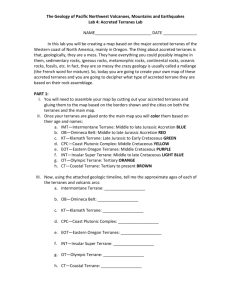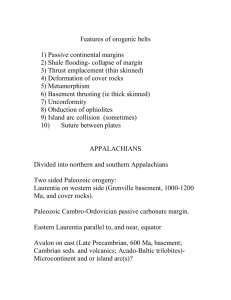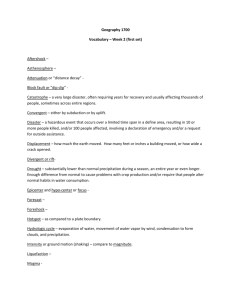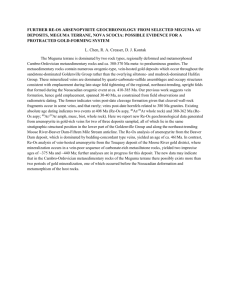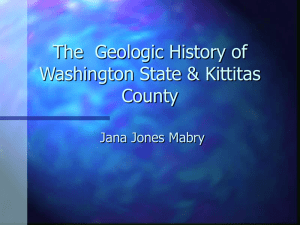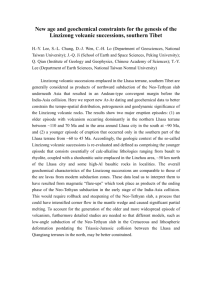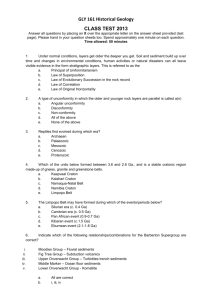Chapter 10 Synthesis and tectonic history
advertisement
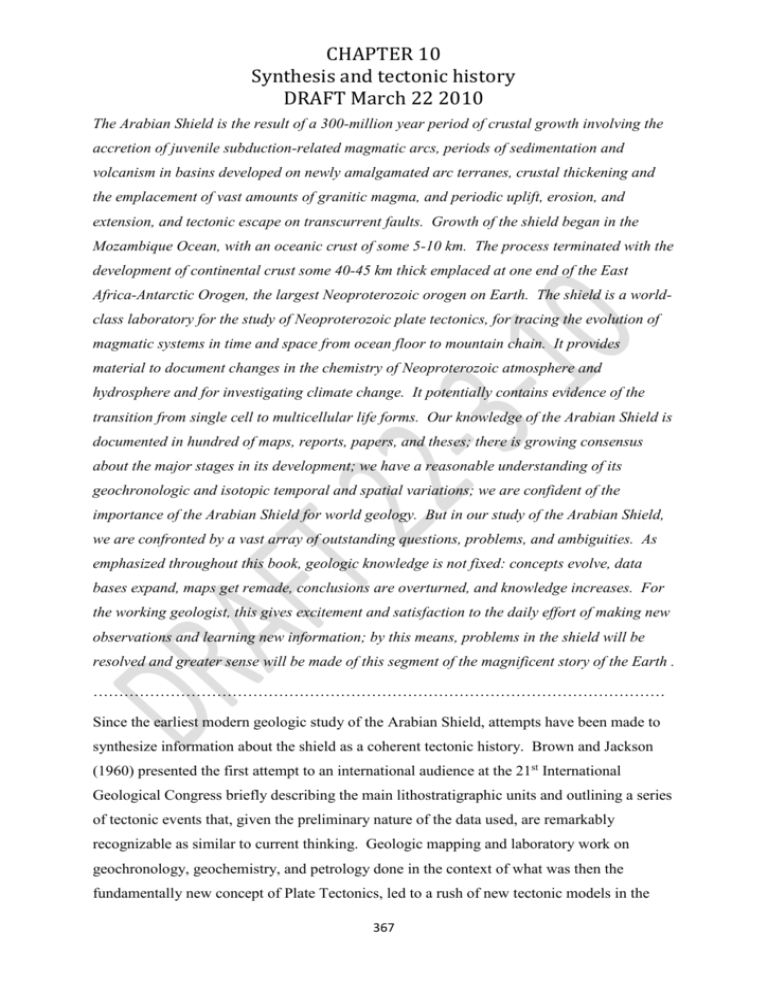
CHAPTER 10 Synthesis and tectonic history DRAFT March 22 2010 The Arabian Shield is the result of a 300-million year period of crustal growth involving the accretion of juvenile subduction-related magmatic arcs, periods of sedimentation and volcanism in basins developed on newly amalgamated arc terranes, crustal thickening and the emplacement of vast amounts of granitic magma, and periodic uplift, erosion, and extension, and tectonic escape on transcurrent faults. Growth of the shield began in the Mozambique Ocean, with an oceanic crust of some 5-10 km. The process terminated with the development of continental crust some 40-45 km thick emplaced at one end of the East Africa-Antarctic Orogen, the largest Neoproterozoic orogen on Earth. The shield is a worldclass laboratory for the study of Neoproterozoic plate tectonics, for tracing the evolution of magmatic systems in time and space from ocean floor to mountain chain. It provides material to document changes in the chemistry of Neoproterozoic atmosphere and hydrosphere and for investigating climate change. It potentially contains evidence of the transition from single cell to multicellular life forms. Our knowledge of the Arabian Shield is documented in hundred of maps, reports, papers, and theses; there is growing consensus about the major stages in its development; we have a reasonable understanding of its geochronologic and isotopic temporal and spatial variations; we are confident of the importance of the Arabian Shield for world geology. But in our study of the Arabian Shield, we are confronted by a vast array of outstanding questions, problems, and ambiguities. As emphasized throughout this book, geologic knowledge is not fixed: concepts evolve, data bases expand, maps get remade, conclusions are overturned, and knowledge increases. For the working geologist, this gives excitement and satisfaction to the daily effort of making new observations and learning new information; by this means, problems in the shield will be resolved and greater sense will be made of this segment of the magnificent story of the Earth . ………………………………………………………………………………………………… Since the earliest modern geologic study of the Arabian Shield, attempts have been made to synthesize information about the shield as a coherent tectonic history. Brown and Jackson (1960) presented the first attempt to an international audience at the 21st International Geological Congress briefly describing the main lithostratigraphic units and outlining a series of tectonic events that, given the preliminary nature of the data used, are remarkably recognizable as similar to current thinking. Geologic mapping and laboratory work on geochronology, geochemistry, and petrology done in the context of what was then the fundamentally new concept of Plate Tectonics, led to a rush of new tectonic models in the 367 CHAPTER 10 Synthesis and tectonic history DRAFT March 22 2010 1970s and 1980s (Schmidt and others, 1973; Greenwood and Brown, 1973; Al-Shanti and Mitchell, 1976; Bakor and others, 1976; Frisch and Al-Shanti, 1977). It became increasingly obvious that the volcanic arcs of the shield had their own particular histories, but eventually shared a common history as the arcs converged and amalgamated to form the continental crust of the shield. This process of convergence and accretion underlies the current main approach to interpreting the history of the shield–the formation and amalgamation of terranes, within a larger context of a supercontinental cycle (see Fig. 1-11). Many variants of this cycle are applied to the Arabian Shield. Some of the earliest were by Camp (1984), Vail (1985), Stoeser and Camp (1985), and Johnson and Vranas (1984). In the 1990s, Agar (1992) made a detailed connection between tectonics and mineralization. Stern (1994) formalized the connections between the Arabian-Nubian Shield and the Mozambique Belt of East Africa, a connection later expanded to include Southern Africa and parts of Antarctica (Jacobs and Thomas, 2004). Genna and others (2002) and Johnson and Woldehaimanot (2003) presented tectonic models that are similar in broad outline but differ in detail and emphasis. Blasband and others (2000) and Collins and Pisarevsky (2005) and others discussed the tectonic history of the Arabian Shield within the context of the global history of Gondwana amalgamation, and Stoeser and Frost (2006) compiled isotopic data that constrain tectonic speculation. The exact number and geographic location of terranes in the shield are debated. Stoeser and Frost (2006), for example, suggest more terranes with different boundaries than shown by Johnson and Woldehaimanot (2003) or Genna and others (2002). Such debate will continue, reflecting the different approaches among geologists who focus on detail and those who focus on the broader picture, and reflecting a growing body of hard information about the timing and significance of volcanic, plutonic, metamorphic, and structural events in many parts of the shield. At the present time, correlations across the shield are commonly suspect, the locations of terrane boundaries are mostly inexact, and the timing of terrane suturing is often uncertain. Nonetheless, it is generally accepted that variations in age of formation, lithologic composition, and degree of mantle input divide the rocks of the shield into fundamental blocks, or terranes, and convergence between the terranes and their accretion with converging Gondwanan units is viewed by all geologists as the primary mechanism of crustal growth in the shield. 368 CHAPTER 10 Synthesis and tectonic history DRAFT March 22 2010 10.1 Arcs and Terrane Accretion With the exception of the Khida terrane, which is a block or microplate of pre-existing continental crust within the Afif composite terrane, and the Ad Dawadimi terrane, which is chiefly made up of sedimentary rock, the shield terranes are late Tonian to Ediacaran magmatic arcs (Fig. 10-1; Table 6-2 in Chapter on Magmatic arcs and plutons). To a first approximation, the terranes are composed of varying proportions of tholeiitic to calc-alkaline series basaltic, andesitic, dacitic, and rhyolitic lavas and pyroclastic units, intercalations of epiclastic and chemical sediments, large amount of mafic and K-rich TTG granitoids, and small but tectonically significant ophiolite complexes. They formed in island-arc to continental-margin settings; they contain an array of arc-related mineral deposits; and they underwent greenschist to amphibolite facies metamorphism during multiple, progressive deformation events. The observed composition of the terranes depends on the level of erosion. Some terranes are dominated by supracrustal volcanic and volcaniclastic rocks; others by more deeply eroded infracrustal plutonic rocks. Some terranes consists of one large magmatic arc and are internally tectonically homogeneous; others are composite, containing more than one arc and reflecting a history of internal amalgamating subterranes. FIG 10-1 ABOUT HERE TIME CHART OF THE SHIELD Some geologists have suggested that in addition to subduction-related arc magmatism, the growth of the Arabian-Nubian Shield was driven also by the rise of a plume head to the shallow mantle, leading to the production of an enriched “plume mantle” and oceanic plateaus (Sten and Goldstein, 1996; Stein, 2003). It is argued that the high rate of crustal accretion in the Arabian-Nubian Shield requires a process different from the “normal” process of arc accretion. Instead, it is proposed that the early stage of crustal growth was initiated and maintained by the upwelling of a mantle plume that spawned oceanic plateaus. Tentative indications of oceanic plateau basalt in the Al Lith area by Reischmann and Kröner (1994) are cited by the authors as evidence for this process. Oceanic plateau are formed by the eruption of vast amounts of oceanic basalt (OPB) on the sea floor in intraplate, not midocean-ridge settings. They have a chondrite-normalized incompatible-element-depleted pattern similar to normal type mid-ocean-ridge basalt (N-MORB) but are chemically distinguished by bein enriched in slected incompatible elements. They were probably derived by hgh degrees of melting from an upper mantl MORB-type sourcewith an enriched oceanic island basalt (OIB) component (Floyd, 1989). During the Creataceous, particularly 369 CHAPTER 10 Synthesis and tectonic history DRAFT March 22 2010 voluminous amount of oceanic plateau basalt related to the Kerguelen mantle plume built up into the giant Large Igneous Provinces (LIP) of the Kerguelen Plateau-Broken Ridge and the Ontong-Java Plateau (Weis and Frey, others. Incorporation of ocean plateaus into accretionary belts is well known. The Alaskan segment of the North American west coast orogen for example contains enormous thrust sheets composed of mafic and ultramafic rocks that were originally confused for ophiolites, but are now known to allochthonous parts of a oceanic plateau (Barker and others, 1988). At the present time it is estimated that ~80 percent or more of the basaltic crust of oceanic basins was generated at mid-ocean-ridge systems. Some 10 pecent formed in forearc and backarc suprasubduction intra-oceanic convergent margins. Ocean plateaus contribute to the remaining 10 percent along with linear volcanic chains, and isolate sea mounts (Hawkins, 2003). By analogy, the contribution of oceanic plateaus to the generation of the Arabian Shield crust is expected to be relatively minor, unless there was major mantle plume activity in the Mozambique Ocean during the early and middle Neoproterozoic. No ocean plateau basalt has been identified in recent investigations of the Arabian shield, but the possibility of ocean plateau allochthons being present in the shield is an interesting topic for further research. 10.2 Afif composite terrane The Afif composite terrane is made up of at least four subunits, the Khida terrane (1800-1650 Ma), and three arcs–the Siham arc (750-685 Ma), the Nuqrah arc (~840 Ma), and the Suwaj arc (~695-685 Ma) (Fig. 10-2). The Khida terrane represents the oldest rocks in the Saudi Arabian part of the Arabian Shield and records a tectonic history that predates the development of the Mozambique Ocean, which was the main site of formation of the Arabian Shield arcs. Older, late Archean crust is found in Yemen (Windley and others, 1996; Whitehouse and others, 1998) and is part of the Arabian Shield but outside the scope of this book. In the Khida terrane, the Paleoproterozoic South Libab gneiss contains material from early Paleoproterozoic sources. It underwent metamorphism at about 1800 Ma and was intruded 140 million years later in the Jabal Khida area by the Muhayil granite and anorthosite (~1660 Ma). These Paleoproterozoic rocks reflect a crustal history long before the growth of any of the Neoproterozoic arcs of the shield. They constitute a crustal block (microplate) now surrounded by Cryogenian volcanic and associated arc plutonic rocks (Siham arc), and intruded by late Cryogenian-Ediacaran granite (Haml batholith). Where the 370 CHAPTER 10 Synthesis and tectonic history DRAFT March 22 2010 microplate came from is unknown. It predates the Rodinia supercontinent and may be a fragment of pre-Rodinia continental crust remaining in the vicinity of the Mozambique Ocean after Rodinia supercontinent rifting and break up. The microplate is commonly correlated with Archean-Paleoproterozoic rocks structurally intercalated with Neoproterozoic arcs in the Arabian Shield in Yemen, and may be part of a once larger bock of continental crust that may even have extended as far as Madagascar (Whitehouse and others, 2001; Collins and Pisarevsky, 2005). Even though Paleoproterozoic rocks have limited exposure confined to the vicinity of Jabal Khida, their presence throughout a large region referred to as the Khida terrene is manifest by evolved isotopic signatures (negative Nd ratios; Type II lead) (Fig. 414, 4-16) and early Paleoproterozoic Nd model ages (Fig. 4-15). These isotopic and model ages are found in surface exposures of Neoproterozoic volcanic and plutonic rocks but indicate the presence of underlying continental crust. FIG 10-2 ABOUT HERE TERRANE MAP Metasedimentary schist and gneiss now embedded in the Khida terrane contain material sourced from Archean and Paleoproterozoic crust, perhaps even from the Muhayil suite, and represent a ~850 Ma pre-Siham phase of magmatism and deposition. The relationship between the pre-Siham metasediments and the Paleoproterozoic rocks at Jabal Khida is not fully certain; the sedimentary rocks may have been deposited unconformably on the Jabal Khida rocks or they may be a separate allochthon, but it is likely that the pre-Siham rocks and Paleoproterozoic crust were in contact by the middle Cryogenian (Fig. 10-3), at which time the Siham group began to form by subduction of oceanic crust beneath the Khida terrane. The Siham group is reported to be unconformable on the Khida microplate (Agar, 1985), implying a period of uplift and erosion prior to the onset of east-directed middle to late Cryogenian subduction that formed the Siham arc. As noted in Chapter 6, the Siham arc developed in a transitional environment from deep water in the west to a shallowwater/continental-margin setting in the east (Fig. 6-20). Calc-alkaline to tholeiitic basalt and andesite are the dominant volcanic rocks, and their chemical signature and Type II leads are consistent with an active continental-margin setting west of the Khida terrane (Fig. 6-21). The Siham arc is not well dated but appears to range between about 750 Ma and 685 Ma, at which time subduction would have largely ceased because of collision between the Afif composite terrane and the Halaban ophiolite on the east and collision with the already amalgamated Hijaz-Jiddah-Asir terranes on the west and south. 371 CHAPTER 10 Synthesis and tectonic history DRAFT March 22 2010 FIG 10-3 ABOUT HERE FLOW DIAGRAM AFIF TERRANE Early Cryogenian arc rocks are present in the northwestern part of the terrane, in the Nuqrah area. Again, robust dating is not available, but the rocks are inferred to be about 840 Ma. Ophiolitic assemblages are associated with arc rocks at Bi’r Tuluhah along the Hulayfah fault zone and at Darb Zubaydah (Fig. 10-4). The Bi’r Tuluhah ophiolite (~845 Ma) possibly formed in a forearc setting, whereas the Darb Zubaydah ophiolite, which is associated with rift-related volcanic and volcaniclastic rocks, may have formed in a backarc at about 830 Ma (Table 10-1). The Nuqrah arc was broadly contemporary with pre-Siham metasedimentary rocks in the Khida terrane, and with sedimentary and volcanic rocks in the Al Lith-BidahShwas area of the Asir terrane. There is, however, no evidence that the Nuqrah, pre-Siham, or Al Lith-Bidah-Shwas assemblages were ever in contact, and they are inferred to have accumulated in separate parts of the Mozambique Ocean. The youngest arc rocks in the Afif composite terrane constitute the Suwaj arc. The arc is deeply eroded, and is represented by infracrustal gabbro, diorite, tonalite, and granodiorite and relatively minor amounts of amphibolite-grade supracrustal rocks. The Suwaj arc may be a continental-margin arc at the eastern edge of the Afif terrane (Al-Saleh and Boyle, 2001) or may be allochtonous and translated into position along terrane bounding faults (Doebrich and others, 2007). It was in place, completing the formation of the Afif terrane collage, by the time of Halaban ophiolite obduction at about 680-675 Ma. FIG 10-4 ABOUT HERE SUMMARY OF OPHIOLITELOCATIONS AND AGES TABLE 10-1 SUMMARY OF OPHIOLITE AGES AND TECTONIC SETTINGS 10.3 Jiddah, Hijaz, and Midyan terranes Among the Neoproterozoic arcs of the shield, the Makkah arc is the oldest ~870-850 Ma, and reflects a late Tonian subduction event in the juvenile Mozambique Ocean. It predates the Nuqrah arc in the Afif terrane and the pre-Siham magmatic/depositional event in the Khida terrane by a few tens of millions of years. The Makkah arc occupies the southern part of the Jiddah terrane as a deeply eroded assemblage of infracrustal plutonic rocks exposed in the Makkah batholith. The arc correlates across the Red Sea with the Erkowit batholith in the Haya terrane, Sudan. Zircon grains from gabbro in the Makkah batholith form a tight cluster dated at 859 Ma but lack indications of inheritance. It would appear therefore that the arc was developing in part of the Mozambique Ocean that neither received sediment from 372 CHAPTER 10 Synthesis and tectonic history DRAFT March 22 2010 surrounding regions of continental crust nor was underlain by evolved crust. During the following 25 million years, the locus of magmatism in this part of the Mozambique Ocean migrated north (present-day coordinates) (Fig. 10-5), perhaps by roll-back of the Makkah arc subduction zone. Early to middle Cryogenian subduction in the new northerly position caused emplacement of the Dhukhr tonalite (816-803 Ma) and volcanic rocks (Arj group and Nida formation) as an early (M1) phase of the Samran-Mahd adh Dhahab arcs (825-800 Ma). This M1 magmatic assemblage was uplifted and eroded between 800 and 785 Ma, following which renewed magmatism resulted in formation of the Mahd group and Shayban formation (Samran group) and emplacement of a TTG suite of intrusive rocks (785-745 Ma). The direction of subduction at this time in the Mozambique Ocean is uncertain, although most models suggest subduction to the south (present-day coordinates) (e.g., Camp, 1984)). Equally uncertain is the number of subduction zones that may have been operating at this time and their proximity to each other, and the extent to which the Samran-Mahd adh Dhahab arcs were primitive to evolving island arcs at an intraoceanic convergent margin or were related to local and periodic extension in a subduction system or Wilson cycle. What is notable, however, is that the presence of inherited zircons in volcanic and plutonic rocks from the northern margin of the Jiddah terrane shows that by the middle Cryogenian the region of the Mozambique Ocean in which the Samran-Mahd adh Dhahab arcs were forming was receiving input from Mesoproterozoic, Paleoproterozoic, and some late Archean sources (Fig. 4-6; Table 4-1). As commented in Chapter 4, the locations of these sources are uncertain, as is the mechanism by which the older zircon grains were incorporated in the Neoproterozoic magmas that generated the volcanic and plutonic rocks. Whatever the mechanism, however, the presence of inherited material did not affect the composition of the Samran-Mahd adh Dhahab arc rocks and in terms of their chemistry and isotopes they are clearly juvenile additions to the crust. They have strongly positive Nd initial ratios, Neoproterozoic Nd model ages (Fig. 4-17, 4-18), and Type I leads (Fig. 4-19). A special feature of the geology of the area is that part of the Samran-Mahd adh Dhahab arc system may have been glaciated during the middle Neoproterozoic. Evidence for possible glaciation comes from the diamictite at the base of the Mahd group, which is broadly contemporary with the Kaigas glacial event (~770-735 Ma) (Stern and others, 2006) (see Chapter 7 for further details). The diamictite is unconformable on the Dhukhr tonalite, implying that the tonalite had been uplifted and eroded sometime in the interval 800-785 Ma. Whether glaciation was an erosive 373 CHAPTER 10 Synthesis and tectonic history DRAFT March 22 2010 agent at this time, or merely a mechanism for introducing poorly sorted siliciclastic material into the area at about 785 Ma, is not clear. FIG 10-5 ABOUT HERE TERRANE PROTOLTH AGES Early to middle Cryogenian subduction and magmatism also affected the southern part of the Hijaz terrane, emplacing the Birak arc (812-800 Ma). As described in Chapter 6, it is possible that the Birak and Samran-Mahd adh Dhahab arcs are parts of a larger arc that were separated by back-arc rifting and subsequently reunited by suturing (a Wilson cycle). The Birak rocks contain Mesoproterozoic, Paleoproterozoic, and late Archean inherited zircons, and have adakitic affinity indicative of slab melting. The Jabal Tharwah (~780 Ma) and Bi’r Umq (~830 Ma) ophiolites were formed in forearc or, possibly, some back-arc environments in the subduction system creating the Samran-Mahd adh Dhahab and Birak arcs. A new phase of subduction roll back or the initiation of a new more northerly subduction zone, led to another phase of northward migration of the locus of magmatism and resulted in formation of the Al Ays arc in the northern part of the Hijaz terrane. The Al Ays arc is an assemblage of middle to late Cryogenian mainly volcaniclastic and sedimentary rocks and subordinate plutonic rocks; it is an example of an arc system in the shield dominated, at the present level of erosion, by its supracrustal components. Available information suggests an age for the Al Ays arc of 745-700 Ma. If this age range proves to be robust, it begs the question of what was happening during the nearly 50 million year gap between the formation of the Birak arc and the Al Ays arc. Was there a complete cessation of subduction and magmatism? Is a similar hiatus apparent in the Gebeit terrane, Sudan, which is correlative with the Hijaz terrane? Or should the timing of Birak arc formation be extended into the middle to late Cryogenian to include the Milhah formation, identified by Camp (1986) as part of an active back-arc basin, so that arc magmatism was more or less continuous? The Al Ays arc is now in contact with the volcanic arc (s) of the Midyan terrane, which represent a long period of arc magmatism between about 780 Ma and 700 Ma. The onset of subduction in the Midyan arc system is indicated by the Jabal Ess (~780 Ma) and Jabal Wask (~750-740 Ma) fore-arc ophiolites that, by analogy with modern forearc ophiolites, would have been emplaced during the early stage of subduction. Cessation of arc formation is effectively constrained by suturing between the Al Ays arc and Midyan arc(s) and emplacement of the Jar-Salajah batholith at about 700 Ma (Fig. 10-7). The area of the 374 CHAPTER 10 Synthesis and tectonic history DRAFT March 22 2010 Mozambique Ocean in which the Midyan arc(s) and equivalents in the Eastern Desert, Egypt were deposited was unique on two counts: (1) it contains extensive glaciogenic diamictites and (2) it was the site of precipitation of iron and silica creating small occurrences of banded iron formation. The diamictite is dated about 750 Ma, 35 million years younger than the possible glaciogenic diamictite at the base of the Mahd group, and is one of several inferred Sturtian diamictites in the Arabian-Nubian Shield (Stern and others, 2006). The banded iron formation is not accurately dated but overlies diamictite in the Eastern Desert and was probably deposited soon after 750 Ma. Chapter 4 discusses some of the issues debated around the question of glaciations in the Neoproterozoic and their relationship to the deposition of banded iron formation, which resumed, worldwide, for a brief interval in the Cryogenian. The matrix of the diamictite in the Midyan arc contains Mesoproterozoic and Paleoproterozoic detrital zircons and a granitoid clast of Neoproterozoic age in the diamictite contains Archean zircons. These reflect a further influx of old material into the Mozambique Ocean. The Jabal Ess and Jabal Wask ophiolitic rocks have strongly positive initial Nd ratios and Type I leads indicating, nonetheless, that the oceanic crust was entirely juvenile. 10.4 Asir terrane The Asir terrane comprises arc rocks in the southern part of the Arabian Shield in Saudi Arabia. As described in Chapter 6, there is doubt about how many separate arcs are present, and whether arcs are coincident with the structural belts of the terrane or whether the structural belts are later features superimposed on the arcs (Greenwood and others, 1982). The arcs appear to be entirely juvenile, with positive initial Nd ratios (Fig. 4-17), late-TonianCryogenian Nd model ages (Fig. 4-18) close to their crystallization ages, and an abundance of Type I leads (Fig. 4-19). The oldest arc rocks in the terrane are in the Al Lith area and the Bidah, Shwas, and Tayyah belts. They are early-middle Cryogenian (>795 Ma) volcanic, volcaniclastic, sedimentary and plutonic rocks representing one or more supracrustal and infracrustal arc assemblages. In terms of their chemistry and lithologies, the rocks resemble typical oceanic-island arc assemblages with a range of basalt to rhyolite volcanic and volcaniclastic rocks, volcanic and epiclastic derived sedimentary rocks, and diorite-TTG plutonic rocks. It is inferred that arc formation had ceased by the time of development of the Tabalah-Tarj shear zone (780-765 Ma) (Table 10-2) interpreted as an intraterrane suture zone and emplacement of the Qiya suite of orthogneiss. The presence of 640-620 Ma adaktic 375 CHAPTER 10 Synthesis and tectonic history DRAFT March 22 2010 granitoids in equivalent arc rocks in Eritrea, suggests that subduction and slab melting may have continued into the late Cryogenian-Ediacaran (Teklay and others, 2001). Kyanitequartz-rich schists are a distinctive feature of the western part of the Afif terrane that correlates readily with a similar rocks in coeval arc assemblages in Eritrea. Geochronologic control is sparse, but the available data suggests an eastward migration of magmatism with time (Fig. 10-5), and rocks in the east of the Asir terrane are middle to late Cryogenian (>727-680 Ma). Detailed geochemistry has not been published, but unpublished data (A.A. Bookstrom, written communication, 1993) suggest complications in the subduction system in the far eastern part of the terrane, with mid-ocean ridge or back-arc basin rocks juxtaposed with suprasubduction island-arc rocks. What appears to be a notable aspect of the Asir terrane is the absence of inherited old zircons (Fig. 4-6), a feature shared by samples dated in coeval rocks in Eritrea (Teklay and others, 2001). This suggests that the subduction system and arc magmatism in this part of the Mozambique Ocean was not sampling older material, which is consistent with the isotopic characteristics that indicate derivation from mantle material for the arc rocks indicating, and from juvenile crustal sources with no or only insignificant contribution from older continental material for later granites,. To the east, the Asir terrane is in contact with strongly metamorphosed volcanic and sedimentary rocks in the Tathlith terrane. The Asir terrane may also be in contact with a northward extension of the Abas gneiss terrane from Yemen (Whitehouse and others, 1998). The Abas terrane consists of undated orthogneisses and supracrustal rocks. Strongly negative present-day time adjusted initial Nd ratios of -18.2 to -5.0 and corresponding tDM model ages from ~1.3-2.3 Ga, and a single Archean zircon core in one sample suggest some involvement of ancient material in the development of the terrane. The Asir/Abas contact is potenitally in high-grade metamorphic rocks east of Najran and if confirmed would present a major tectonic boundary in the southern part of the shield. 10.5 Ad Dawadimi and Ar Rayn terranes The Ad Dawadimi and Ar Rayn terranes are the youngest terranes in the Saudi Arabian Shield (Fig. 10-1, 10-2. 10-5). The Ad Dawadimi terrane consists of the Abt formation, a sandstone-siltstone unit deposited between about 600 Ma and 570 Ma; the Ar Rayn terrane comprises the Al Amar arc and associated plutonic suites (>690-580 Ma). As mentioned several times in this book, their tectonic setting is the subject of considerable debate. 376 CHAPTER 10 Synthesis and tectonic history DRAFT March 22 2010 Fundamental constraints on the outcome of this debate involve: (1) the shape and size of the Ad Dawadimi and Ar Rayn terranes vis-a-vis terranes farther west, (2) the Ediacaran age of the Abt formation, and (3) indications of ongoing subduction in the Ar Rayn terrane as late as about 580 Ma. In terms of size and shape, the two terranes form parallel, north-trending structural blocks 45-80 km wide where exposed at the extreme eastern margin of the shield that extend into Iraq, far north of the other terranes exposed on the shield (Figs. 1-9, 3-1, 314) (Johnson and Stewart, 1995). From this perspective, the two terranes must be discussed together, and their tectonic setting cannot be discussed merely with respect to the Afif terrane alone, but must take account of their discordant structural relationships with both the Afif and Ha’il terranes. The age of the Abt formation limits the timing of amalgamation between the joint Ad Dawadimi/Ar Rayn terranes and other terranes to the west to sometime after ~570 Ma. Published tectonic interpretations of the Ad Dawadimi and Ar Rayn terranes focus on variants of one or other of two models: an east-dipping subduction system or a west-dipping system (Fig. 10-6). Al-Saleh and Boyle (2001) envisage early west-dipping subduction beneath the Afif terrane causing magmatism in Suwaj arc, followed by roll-back leading to splitting of the arc and opening of a back-arc basin. Magmatism continued, creating the Al Amar arc, and the Abt formation was deposited in the back arc. Eventual collision with an eastern crustal block led to cessation of subduction and amalgamation of the Ar Rayn and Ad Dawadimi terranes with the Afif terrane. A variant model (Doebrich and others, 2007) involves a single subduction system that from the outset creates the Ar Rayn terrane and a passive margin or back-arc type of basin for the Abt formation. But as in the Al-Saleh and Boyle model, cessation of subduction and terrane amalgamation resulted from collision with an Eastern Block. Another variant, given by Lewis (2009), is similar to the Al-Saleh and Boyle model in that there is a jump in the subduction zone from west to east leading to formation of the Ar Rayn terrane deposition of the Abt formation in the basin between the Afif and Ar Rayn terranes. The easterly-dipping subduction model of Stacey and others (1984) (Fig. 10-6 D) treats the Abt formation as a forearc/accretionary-wedge with respect to a subduction zone dipping beneath the Al Amar arc. Sharland and others (2001) also model an east-dipping subduction zone for the region at the eastern edge of an ocean, referred to as the Amar Sea. The Al Amar arc was created above the subduction zone and the Abt formation was deposited in the 377 CHAPTER 10 Synthesis and tectonic history DRAFT March 22 2010 Amar Sea. An easterly dipping subduction-zone model is preferred by the present author because it allows the Abt formation to be deposited in a large north-trending forearc basin flanking the Al Amar arc, as required by the aeromagnetic data (Fig. 3-1). It also allows the Ad Dawadimi and Ar Rayn terranes to be at some remove from the already amalgamated Afif and Ha’il terranes and others terranes farther west in the shield, permitting sedimentation of the Abt formation until about 580 Ma, and allows final collision between the Ad Dawadimi/Ar Rayn and other terranes after 580 Ma. FIG 10-6 ABOUT HERE SUBDUCTION MODELS EASTERN SHIELD The Abt formation and Al Amar arcs have lead isotopes intermediate between the evolved leads of the Khida terrane and the juvenile leads of the western shield terranes (Fig. 4-19) and Nd model ages somewhat older than their formation/deposition ages (Fig. 4-18). Deposition of the Abt formation reflects a large influx of detritus into what remained at this stage of the Mozambique Ocean (Fig. 4-6). Neoproterozoic detrital zircons in the Abt formation could be derived from either the Afif terrane or the Ar Rayn terrane. In this respect the zircons are unfortunately nondiagnostic about their provenance and do not positively support either one of the tectonic settings proposed for the group. Other detrital grains are from Paleoproterozoic and Mesoproterozoic sources, and in one instance from a late Archean source. The Paleoproterozoic and late Archean grains could be derived from Khida-terrane type continental crust; the source of the Mesoproterozoic grains is unknown. 10.6 Accretionary events and closure of the Mozambique Ocean The timing of accretion in the Arabian Shield is extensively described by Stoeser and Camp (1985), Johnson and Woldehaimanot (2003), and is discussed in Chapter 9: Structure. Fig. 10-7 summarizes the accretionary/suturing history and shows the timing of movements on prominent shear zones in the shield. In some instances, the shear zones are the boundaries between terranes; in other instances they reflect strike-slip, shortening events; and in other instances they are terrane-disrupting transcurrent faults reflecting north-south orogen extension and tectonic escape. As emphasized in Chapter 9, the timing of suturing and shearing is not uniformly well constrained. But available geochronologic data indicates that movements on several of the prominent shear zones were contemporary with terrane suturing, creating kinematic interrelationships that need to be explained by any tectonic model adopted for the accretion of the shield. 378 CHAPTER 10 Synthesis and tectonic history DRAFT March 22 2010 FIG 10-7 ABOUT HERE TIMING OF ACCRETION AND SHEARING The earliest shearing and suturing in the Arabian Shield is evidenced by 780-765 Ma dextral strike-slip on the Tabalah-Tarj shear zone in the central part of the Asir terrane (Blasband, 200x), and emplacement of syntectonic Qudayd suite tonalite gneiss (780-751 Ma) along the Bi’r Umq suture between the Jiddah and Hijaz terrane (Hargrove, 2006). These events are not necessarily directly related because there is no evidence that the western part of the Asir terrane was in contact with the Jiddah or Hijaz terrenes at this stage, nor do we know the relative orientations of the shear zone and suture zone. Subsequent suturing occurred along the Yanbu suture at ~700 Ma, reflecting amalgamation between the Hijaz and Midyan terranes in Saudi Arabia and the Gebeit and Eastern Desert terranes in Sudan and Egypt. Suturing here was complete by the time of emplacement of the Jar-Salajah batholith that discordantly intrudes the Yanbu suture, most reliably dated as between 715-695 Ma (Pallister and others, 1988; Kennedy and others 2004). The western terranes of the Arabian Shield were in place by the time of convergence with the Afif composite terrane, believed to be about 680-640 Ma (Stoeser and Stacey, 1988; Johnson and Kattan, 2001). The suture zone, labeled on Fig. 10-7 the “Afif terrane suture”, is represented by the Hulayfah-Ad Dafinah-Ruwah fault zone. The Ruwah fault as observed today is, strictly speaking, a Najd fault with evidence of strike-slip between 630 Ma and 530 Ma, but the Najd movement is interpreted as superimposed on or a reactivation of an earlier southeast-trending part of the Afif terrane suture. Convergence between the Tathlith and Asir terrane likely also occurred at this time, contemporary with emplacement of the large syntectonic gneiss batholiths that characterize the Nabitah fault zone in the Khamis Mushayt and Jabal Qaha area. These 680-640 episodes of terrane amalgamation and syntectonic gneiss emplacement are the primary features that define the Nabitah orogeny (680-640 Ma; Stoeser and Stacey, 1988). The orogeny is particularly evidenced in a broad north-south zone across the shield encompassing the sutures between the Afif and Tathlith terranes with the Hijaz-Jiddah-Asir terranes, but movements on the Qazaz and Ajjaj shear zones at this time in the Midyan terrane as possibly far-field effects of the orogeny. The youngest amalgamation event in the Arabian shield is represented by Ediacaran accretion of the Ad Dawadimi and Ar Rayn terranes with the Afif terrane. The timing of this event, as suggested by four lines of evidence, appears to have been protracted between about 615 Ma and 580 Ma or later: (1) completion of amalgamation reasonably coincided with cessation of 379 CHAPTER 10 Synthesis and tectonic history DRAFT March 22 2010 deposition of the Abt formation at about 580 Ma; (2) earlier stages in amalgamation between 610 Ma and 596 Ma are evidenced by 40Ar/39Ar dating of hornblende in amphibolite and gabbro in the Ar Ridaniyah ophiolite in the central part of the Ad Dawadimi terrane that are interpreted as the time when hornblende cooled below its blocking temperature (Al-Saleh and Boyle, 2001); (3) 40Ar/39Ar dating of biotite and hornblende from the Artawi structural window east of the Halaban ophiolite indicates rapid uplift and cooling at about 600 Ma at the western margin of the terrane (Al-Saleh and others, 1998); (4) 40Ar/39Ar ages of muscovite in the Abt formation indicate metamorphism at 616±3 Ma and 613±6 Ma (Lewis, 2009). An earlier orogenic event at about 680-675 Ma is indicated by the timing of emplacement of the Halaban ophiolite. It should be noted that the relationship between obduction of the Halaban ophiolite, deposition of the Abt formation, and emplacement of the Ar Rayn arc is not fully clear at this stage, nor is it obvious where the Halaban ophiolite originated with respect to either the Afif terrane or the Abt formation. The Ad Dawadimi and Ar Rayn terranes are interpreted by Al-Husseini (2000) as the leading, westerly edge of the Ar Rayn microplate, a crustal block in the basement of central Saudi Arabia (Fig. 8-37). Docking of this plate with the already amalgamated terranes farther west in the Arabian-Nubian Shield at about 580 Ma or soon after marked completion of accretion of the Arabian-Nubian Shield and a terminal stage in closure of the Mozambique Ocean. Amalgamation by about 600 Ma of the western Arabian shield-Nubian Shield and the Saharan metacraton along the Keraf suture in Sudan (Abdelsalam and others, 1998, 2003) signaled the beginning of ocean closure. Final closure of the ocean did not occur until continent-continent collision between India and the East African cratons at about 550-520 Ma (Collins and Pisarevsky, 2005). Closure of the Mozambique Ocean marked assembly of the various components of East and West Gondwana and creation of the East African-Antarctic Orogen (Stern 1994). Crustal shortening associated with this assembly caused the development of a range of concurrent structures in the Arabian-Nubian Shield reflecting east-west shortening, north-south extension, uplift, and orogenic collapse. As described in Chapter 9, the most prominent of these structures are northwest-trending strike-slip faults of the Najd fault system. Most Najd faults contain large components of sinistral shear caused by oblique transpression and many of the Najd faults have a component of vertical uplift as well as north-south orogen-parallel extension. Uplift is evidenced by the mineral and stretching lineations that have a gently 380 CHAPTER 10 Synthesis and tectonic history DRAFT March 22 2010 plunge along the faults and by the gneiss antiforms that crop out along the axes of the faults. Gneiss domes implying basement exhumation, and according to some geologists implying extension and orogenic collapse on low-angel detachment faults, are identified in the Eastern Desert of Egypt and in Sinai (e.g., Blasband, 2006; Fritz and others, 1996). Mantle gneiss domes are potentially present along the Qazaz shear zone in the Arabian Shield. Northward extension, or tectonic escape, in the Arabian-Nubian Shield was in the direction of the ocean bordering the orogen in the north. Complementary southward extension occurred in the southern part of the orogen in South Africa (Jacobs and Thomas, 2004). By the end of the Neoproterozoic, the northern part of the orogen was a relatively stable region facing the northern ocean, and by about 530 Ma was the site of deposition of a thick blanket of sandstone, terminating, for the purpose of this book, the history of the Arabian Shield. To the west, active margins were present during the early Paleozoic, the source of magmatic rocks now preserved in peri-Gondwana domains in Eurasia and North America. Farther south in the orogen, high-grade metamorphism and contractional deformation persisted until about 520 Ma, ceasing with the collision of India with the orogen. As described above, Gondwana persisted until the Mesozoic, embedded in the core of Pangea. Peri-Gondwana fragments rifted off during the Ordovician, middle Silurian, and middle Permian-Triassic, but pervasive breakup did not occur until the Early to Middle Jurassic. The most recent breakup of the central Gondwana remnant is the separation of northeasternmost Africa to form the Arabian Plate. The Neoproterozoic crust of Arabia is now detached from its origins, and the future history of the Arabian Shield lies in Eurasia rather than Gondwana. The Arabian Plate is amalgamating with the Eurasian Plate, and the two will move across the face of the Earth as conjoined crust, unless the Arabian Plate is overtaken by further breakup, for example along the Makkah-Madinah line, or obliterated by ongoing subduction beneath the Zagros thrust. 381
